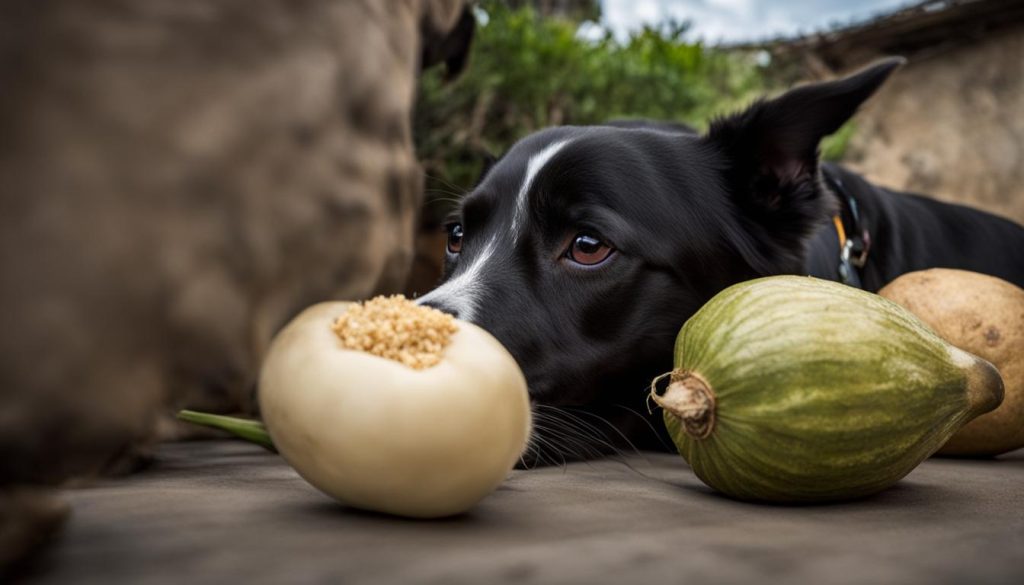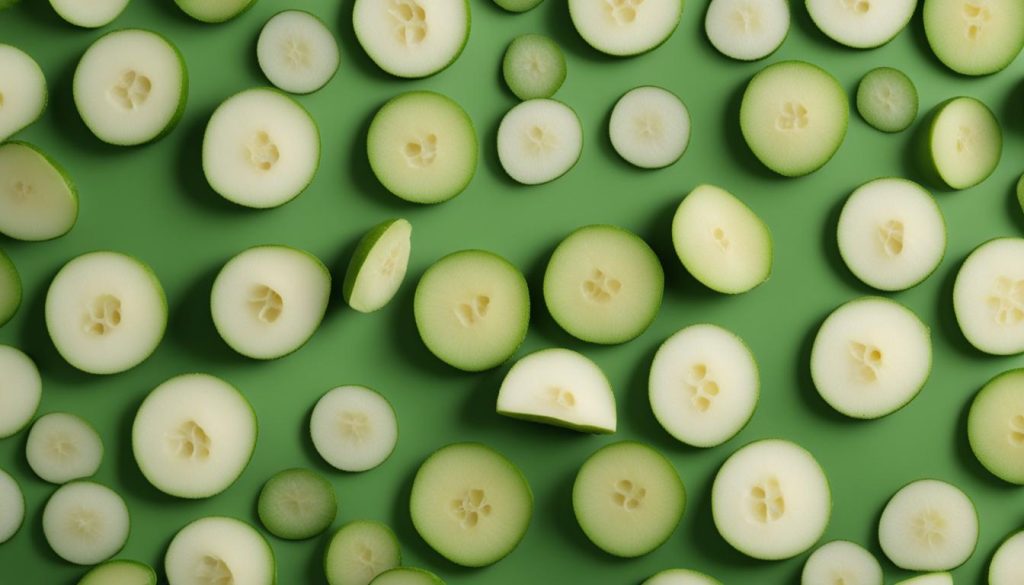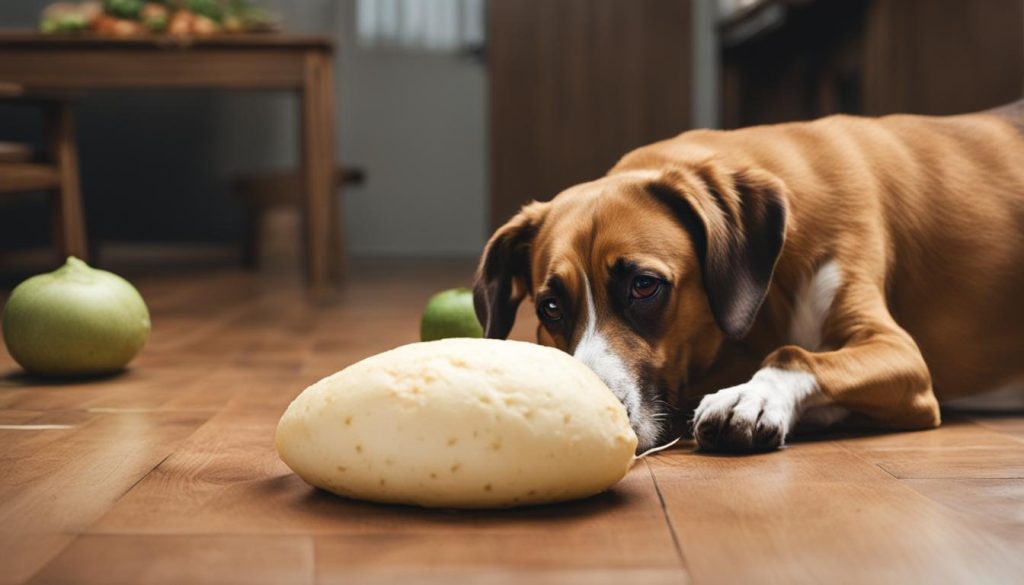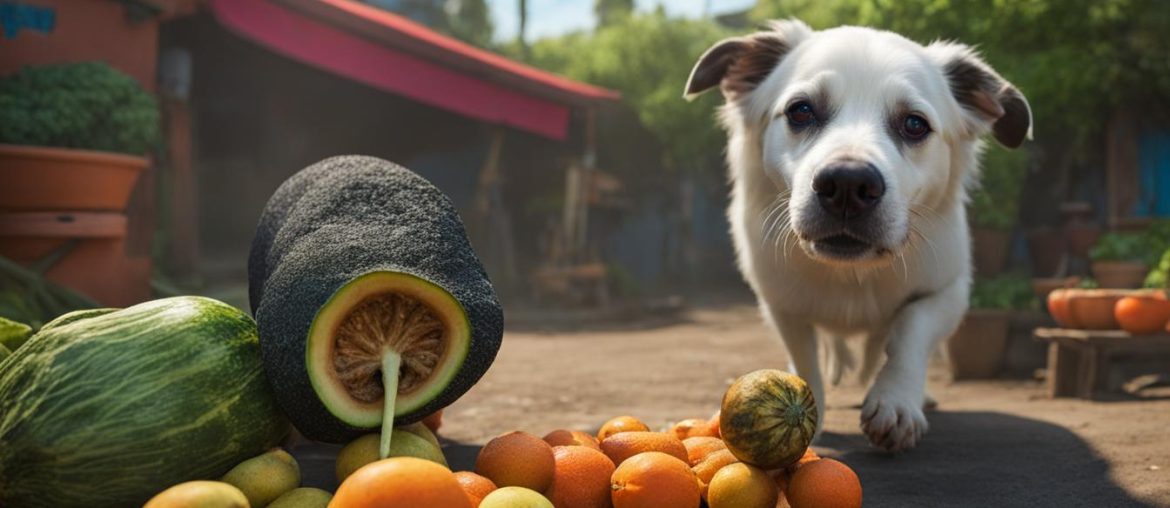In today’s article, we will delve into the topic of whether dogs can safely consume jicama, a root vegetable also known as the Mexican turnip. As responsible pet owners, it’s essential to consider the nutritional options available for our furry friends. So, let’s explore the potential benefits, risks, and considerations surrounding jicama and its suitability for inclusion in your dog’s diet.
Key Takeaways:
- Jicama, a root vegetable and member of the pea family, can be a safe and healthy treat for dogs when fed in moderation.
- Only the peeled jicama flesh is safe for dogs to consume; other parts of the plant, such as the skin, leaves, seeds, and stem, are toxic and should be avoided.
- Jicama offers numerous nutritional benefits for dogs, including antioxidants, dietary fiber, vitamins, and minerals.
- However, excessive consumption of jicama may lead to constipation or gastrointestinal issues, so it’s important to monitor your dog’s intake.
- Prior to introducing jicama into your dog’s diet, it’s always wise to consult with a veterinarian to ensure it aligns with their specific needs and health condition.
What is Jicama?

Jicama, scientifically known as Pachyrhizus erosus, is a root vegetable that originates from Mexico. It belongs to the pea family and is commonly referred to as the Mexican turnip. Jicama has an oblong shape with a light-brown rough skin similar to a potato. The flesh of the root is creamy white and crunchy, with a sweet flavor resembling that of an apple or pear.
As a member of the pea family, jicama is a legume, but it is the root of the plant that is consumed. It is a versatile vegetable that can be eaten raw or cooked and is popular in various cuisines around the world. Jicama is known for its crisp and refreshing texture, making it a favorite ingredient in salads, slaws, and stir-fries.
With its mild and slightly sweet taste, jicama can be a great addition to both savory and sweet dishes. It adds a satisfying crunch and a refreshing flavor that complements a wide range of ingredients. Whether enjoyed on its own as a snack or incorporated into a delicious recipe, jicama offers a unique and delightful culinary experience.
Can Dogs Have Jicama?

Yes, dogs can have jicama as part of their diet, but it is important to follow certain guidelines to ensure their safety and well-being. Jicama can be a healthy and tasty treat for dogs when given in moderation and prepared properly. However, there are specific considerations to keep in mind when feeding jicama to dogs.
Firstly, it is crucial to only feed dogs peeled jicama. Other parts of the jicama plant, such as the skin, leaves, seeds, and stem, are toxic and should not be consumed by dogs. To prepare jicama for dogs, thoroughly wash it to remove any dirt or potential pesticides. Peel off the tough outer skin before cutting it into small, manageable pieces.
It is also important to introduce jicama slowly into your dog’s diet. Start by giving them small amounts and monitor their reaction. Some dogs may take time to adjust to the new taste and texture of jicama, so be patient and observe if they enjoy it. If your dog shows any signs of distress or discomfort after consuming jicama, discontinue feeding it to them and consult with a veterinarian.
Table: Benefits of Feeding Jicama to Dogs
| Nutritional Benefit | Description |
|---|---|
| Dietary Fiber | Supports healthy digestion and nutrient absorption. |
| Antioxidants | Help protect cells and reduce the risk of illnesses. |
| Vitamins and Minerals | Provides essential nutrients such as vitamin C, iron, magnesium, and phosphorus. |
Jicama can be a nutritious addition to a canine diet, offering dietary fiber, antioxidants, vitamins, and minerals. It provides a crunch that dogs may enjoy, making it a great alternative to high-calorie or processed treats. However, it is essential to remember that jicama should never replace a balanced and tailored diet specifically designed for your dog’s unique nutritional needs.
Overall, with proper preparation and moderation, jicama can be a safe and healthy treat for dogs. Consult with a veterinarian to determine the appropriate amount of jicama to feed your dog based on their size and individual dietary requirements. By following these guidelines, you can introduce jicama as an occasional addition to your dog’s diet and provide them with a nutritious and enjoyable treat.
Is Jicama Good for Dogs? Nutritional Benefits of Jicama for Dogs
Jicama is not only a safe treat for dogs but also offers numerous nutritional benefits. It is packed with essential vitamins and minerals that contribute to your dog’s overall health and well-being. Here are some of the key nutritional benefits of including jicama in your dog’s diet:
- Vitamin C: Jicama is an excellent source of vitamin C, which supports your dog’s immune system and helps protect against diseases and infections.
- Dietary Fiber: The high fiber content in jicama promotes healthy digestion and helps prevent constipation in dogs. It also supports weight management and can be beneficial for dogs with gastrointestinal issues.
- Hydration: Jicama has a high water content, making it a hydrating snack for dogs, especially during hot summer months or after physical activity.
- Antioxidants: Jicama contains antioxidants that help combat free radicals in your dog’s body, reducing the risk of chronic diseases and cellular damage.
- Low in Calories: Jicama is a low-calorie vegetable, making it a suitable treat for dogs who need to watch their weight or are on a calorie-restricted diet.
These nutritional benefits make jicama a nutritious addition to your dog’s diet. However, it is important to note that every dog is different, and individual dietary needs may vary. Consult with your veterinarian to determine the appropriate portion size and frequency of jicama treats for your dog, taking into consideration their overall diet and any specific health conditions they may have.
Remember, moderation is key when introducing new foods to your dog’s diet. Start by offering small amounts of jicama and monitor your dog’s reaction. If any adverse symptoms occur, such as gastrointestinal upset or allergic reactions, discontinue feeding jicama and seek veterinary advice.
What Parts of Jicama are Safe for Dogs to Eat?
When it comes to feeding jicama to dogs, it’s important to know which parts are safe for their consumption. While the flesh of the jicama root is safe and nutritious for dogs, other parts of the plant can be toxic and should be avoided. Here’s a breakdown of what is safe and what to avoid:
| Safe for Dogs | Toxic for Dogs |
|---|---|
| Jicama Flesh: Dogs can enjoy the crunchy, sweet flesh of jicama as a healthy treat. | Jicama Skin: The skin of jicama is toxic to dogs and should always be peeled before feeding. |
| Jicama Leaves: Jicama leaves contain harmful compounds and should not be consumed by dogs. | |
| Jicama Seeds: The seeds of jicama are also toxic to dogs and should be avoided. | |
| Jicama Stem: Dogs should not eat the stem of the jicama plant as it can cause health complications. |
It’s crucial to ensure that dogs only consume the safe parts of jicama to prevent any potential health risks. Always peel the jicama before giving it to your dog and remove any other non-edible parts. By doing so, you can safely incorporate jicama into your dog’s diet as a tasty and nutritious treat.
Potential Risks of Feeding Jicama to Dogs

While jicama can be a safe and healthy treat for dogs, it is important to be aware of some potential risks associated with feeding jicama to dogs. One potential risk is the possibility of constipation. Jicama is high in fiber, and an excessive amount of jicama in a dog’s diet can lead to digestive issues and difficulty in passing stools.
Another potential risk is gastrointestinal problems. Some dogs may have trouble digesting jicama, especially if they have a sensitive stomach or a history of digestive issues. It is important to introduce jicama slowly into their diet and monitor their reaction to it.
In rare cases, jicama can be toxic to dogs. While the flesh of the jicama root is safe for dogs to eat, other parts of the plant, such as the skin, leaves, seeds, and stem, contain toxic compounds that can be harmful to dogs if ingested. It is crucial to ensure that only the peeled flesh of the jicama root is given to dogs and to avoid any other parts of the plant.
As with any new food or treat, it is always recommended to consult with a veterinarian before introducing jicama into your dog’s diet. They will be able to provide personalized advice based on your dog’s specific needs and health condition, ensuring the safety and well-being of your furry friend.
| Potential Risks of Feeding Jicama to Dogs |
|---|
| Constipation |
| Gastrointestinal problems |
| Toxicity (from other parts of the plant) |
Preparation Tips for Feeding Jicama to Dogs
When it comes to feeding jicama to dogs, proper preparation is key to ensure its safety and enjoyment. Here are some helpful tips:
- Thoroughly wash the jicama to remove any dirt or potential pesticides. This step is important to ensure your dog’s health and well-being.
- Peel off the tough outer skin of the jicama before serving it to your dog. The skin is not safe for consumption and should be discarded.
- Cut the jicama into small, bite-sized pieces appropriate for your dog’s size. This will make it easier for them to chew and digest.
- You can add the jicama pieces to your dog’s regular meal as a crunchy and nutritious addition, or you can offer them as occasional treats.
Remember to monitor your dog’s stool after introducing jicama into their diet to ensure they tolerate it well. If you notice any adverse reactions, such as diarrhea or vomiting, discontinue feeding jicama and consult with your veterinarian for further guidance.
Introducing jicama into your dog’s diet can be a fun and healthy way to diversify their treats and provide them with additional nutrients. However, it is essential to consult with a veterinarian before making any major dietary changes for your dog, including the introduction of new foods like jicama.
| Preparation Tips for Feeding Jicama to Dogs |
|---|
| Thoroughly wash the jicama to remove any dirt or potential pesticides. |
| Peel off the tough outer skin of the jicama before serving it to your dog. |
| Cut the jicama into small, bite-sized pieces appropriate for your dog’s size. |
| Add the jicama pieces to your dog’s regular meal or offer them as occasional treats. |
| Monitor your dog’s stool after introducing jicama to ensure they tolerate it well. Discontinue feeding jicama if any adverse reactions occur. |
By following these preparation tips and consulting with your veterinarian, you can safely and confidently introduce jicama into your dog’s diet, providing them with a tasty and nutritious treat.
How Much Jicama Can a Dog Eat?

Feeding jicama to dogs should be done in moderation to ensure their overall well-being. The appropriate jicama quantity for dogs depends on factors such as their size, weight, and individual dietary needs. As a general guideline, it is recommended to limit the serving size to no more than a quarter cup of jicama sticks at a time. This ensures that dogs receive the nutritional benefits of jicama without exceeding their caloric intake or risking potential digestive issues.
When introducing jicama into a dog’s diet, it’s important to watch their reaction and monitor their stool for any signs of discomfort or digestive upset. Dogs that are new to jicama should start with smaller portions and gradually increase the amount over time. Additionally, it is important to consult with a veterinarian before incorporating jicama into a dog’s diet, as they can provide specific guidance based on the dog’s individual needs.
Table: Jicama Quantity Guidelines for Dogs
| Dog Size | Serving Size (Jicama Sticks) |
|---|---|
| Small (up to 25 pounds) | 1 to 2 sticks |
| Medium (26 to 50 pounds) | 2 to 3 sticks |
| Large (51 to 75 pounds) | 3 to 4 sticks |
| Extra Large (76 pounds and above) | 4 to 5 sticks |
Remember, each dog is unique, and their dietary needs may vary. It is always best to consult with a veterinarian to determine the appropriate jicama serving size for your furry friend.
To summarize, jicama can be a healthy and enjoyable treat for dogs when given in moderation. By following the recommended jicama portion guidelines and consulting with a veterinarian, you can ensure that your canine companion receives the nutritional benefits of jicama while maintaining a balanced diet.
How Long Can Jicama Be Stored?
Jicama, like any other food, has a limited shelf life. Proper storage is essential to maintain its freshness and quality for as long as possible. Here are some guidelines on how long you can store jicama:
- Whole and unpeeled jicama can be stored in the refrigerator for up to two weeks. It is important to keep it in a cool and dry place to prevent moisture buildup.
- If you have already peeled the jicama, it can be stored in an airtight container filled with water. This will help maintain its crispness and prevent it from drying out. Peeled jicama can be stored in the refrigerator for up to three days.
- Alternatively, you can freeze jicama to extend its shelf life. Peel and cut the jicama into desired pieces, then store them in an airtight container. Frozen jicama can last for up to six months.
Remember that the quality of jicama may deteriorate over time, so it is best to consume it as fresh as possible for optimal flavor and texture. Always check for any signs of spoilage or discoloration before using stored jicama.
Table:
| Jicama Storage Method | Storage Duration |
|---|---|
| Whole and unpeeled jicama in the refrigerator | Up to two weeks |
| Peeled jicama in an airtight container with water in the refrigerator | Up to three days |
| Frozen jicama in an airtight container | Up to six months |
Proper storage practices ensure that your jicama remains fresh and safe for your furry friend to enjoy. By following these guidelines, you can make the most out of your jicama and provide your dog with a healthy and delicious treat for an extended period.
Signs Your Dog Isn’t Enjoying Jicama

While jicama can be a safe and healthy treat for dogs, not all dogs may enjoy the taste or texture of this root vegetable. It’s important to pay attention to your dog’s reactions when introducing jicama into their diet. Here are some signs that your dog may not be enjoying jicama:
- Refusing to eat jicama: If your dog consistently turns away from jicama or refuses to eat it, it may be a sign that they simply don’t enjoy the taste.
- Showing signs of distress or anxiety: Some dogs may exhibit signs of discomfort when consuming jicama, such as pacing, whining, or excessive drooling.
- Vomiting or having diarrhea: If your dog experiences digestive issues, such as vomiting or diarrhea, after eating jicama, it may indicate that their system does not tolerate it well.
- Avoiding contact with jicama: Dogs have preferences just like humans, and they may actively avoid interacting with jicama, such as sniffing it and walking away.
If you observe any of these signs, it’s best to respect your dog’s preferences and discontinue feeding them jicama. Every dog is unique, and while some may enjoy jicama as a treat, others may simply dislike it. Always prioritize your dog’s well-being and consult with a veterinarian if you have any concerns about their diet or reactions to specific foods.
Potential Risks and Wrapping Up
While jicama can be a safe and healthy treat for dogs when given in moderation, it is important to be aware of the potential risks associated with its consumption.
One potential risk is the development of constipation or gastrointestinal problems. Excessive intake of jicama can disrupt the digestive system and cause discomfort for your dog. Additionally, jicama contains oxalates, which can be harmful to the kidneys and pose a risk of renal damage.
To summarize, while jicama can provide nutritional benefits and hydration for dogs, it should never replace a balanced and tailored diet for their specific needs. It is important to introduce jicama slowly into your dog’s diet, monitor for any adverse reactions, and consult with a veterinarian before making any significant dietary changes. By doing so, you can ensure the health and well-being of your furry companion.
FAQ
Can dogs eat jicama?
Yes, dogs can eat jicama as long as it is peeled and given in moderation.
Is jicama safe for dogs?
Jicama is safe for dogs to eat, but only the peeled flesh of the root. Other parts of the jicama plant, such as the skin, leaves, seeds, and stem, are toxic and should be avoided.
What are the nutritional benefits of jicama for dogs?
Jicama is packed with antioxidants, dietary fiber, vitamins, and minerals, making it a nutritious treat for dogs.
How should I prepare jicama for my dog?
Thoroughly wash the jicama, peel off the tough skin, and cut it into small pieces appropriate for your dog’s size.
How much jicama can a dog eat?
It is recommended to limit the jicama quantity to no more than a quarter cup of jicama sticks at a time.
How long can jicama be stored?
Jicama can be stored for up to two weeks in the refrigerator when kept whole and unpeeled. If peeled, it can be stored in an airtight container with water for up to three days, or frozen for up to six months.
What are the signs that my dog isn’t enjoying jicama?
Signs that your dog may not be enjoying jicama include refusing to eat it, showing signs of distress or anxiety, vomiting or having diarrhea after eating it, and avoiding contact with the jicama.
Are there any risks associated with feeding jicama to dogs?
Excessive consumption of jicama can lead to constipation, gastrointestinal problems, and potential toxicity. It is important to introduce jicama slowly and monitor for any adverse reactions.
Can jicama replace a balanced diet for dogs?
No, jicama should never replace a balanced and tailored diet for your dog’s specific needs. It should only be given as an occasional treat.
Should I consult with a veterinarian before giving jicama to my dog?
Yes, it is always recommended to consult with a veterinarian before introducing any new food or treat into your dog’s diet.
What are the potential risks of feeding jicama to dogs?
Potential risks of feeding jicama to dogs include constipation, gastrointestinal problems, and potential toxicity due to oxalates present in jicama.
Can jicama be toxic to dogs?
While the flesh of jicama is safe for dogs, other parts of the jicama plant, such as the skin, leaves, seeds, and stem, are toxic. Ingesting these parts can cause severe health complications.






